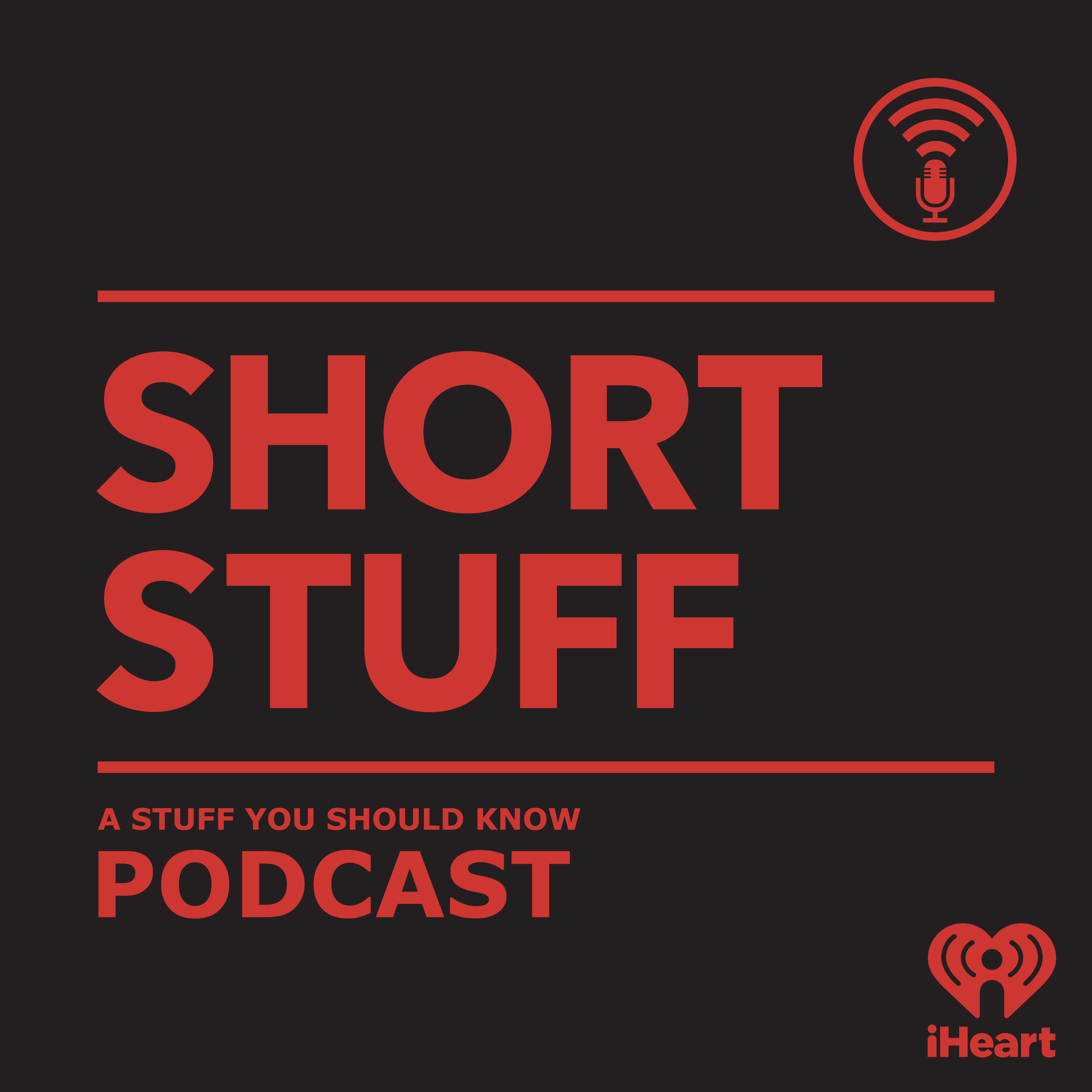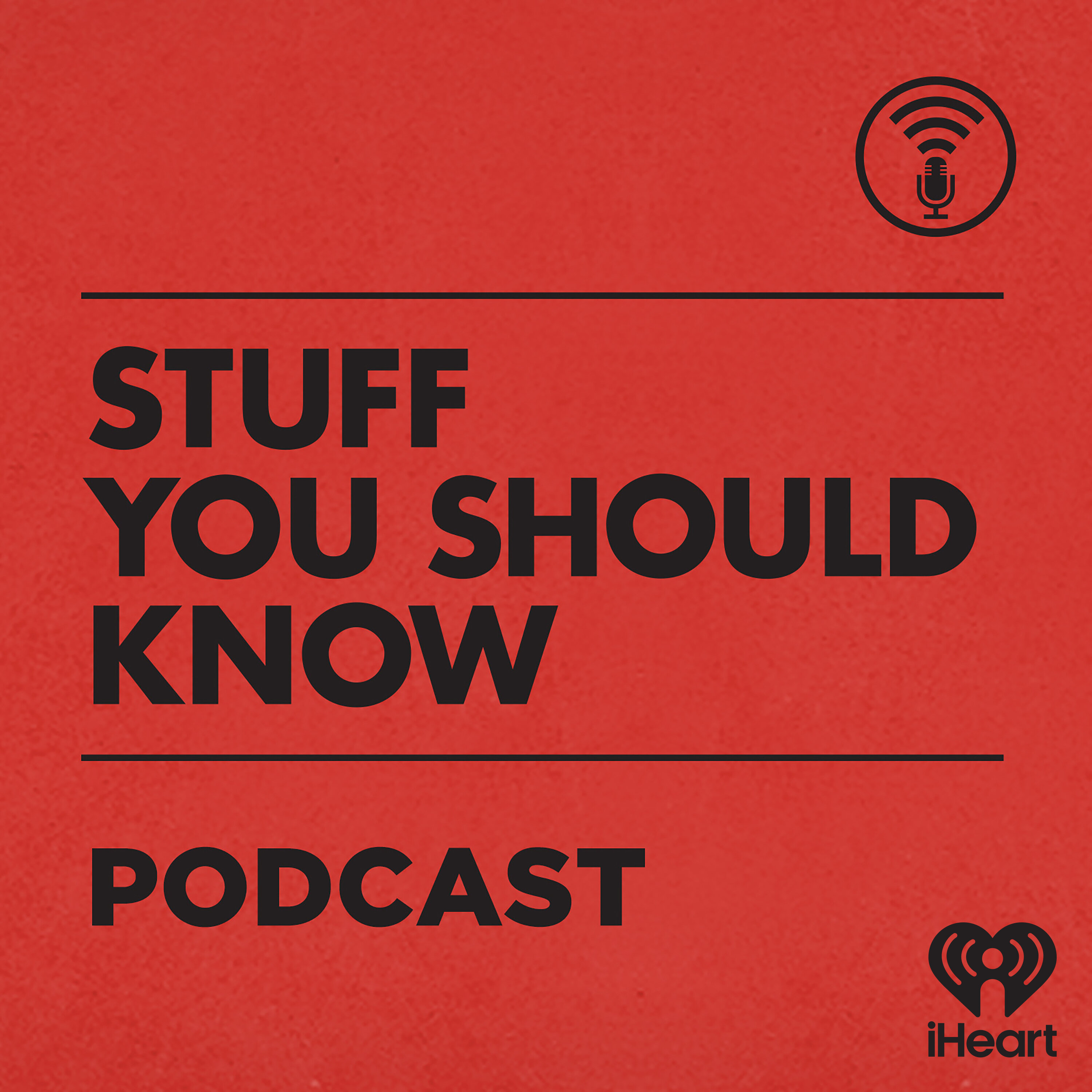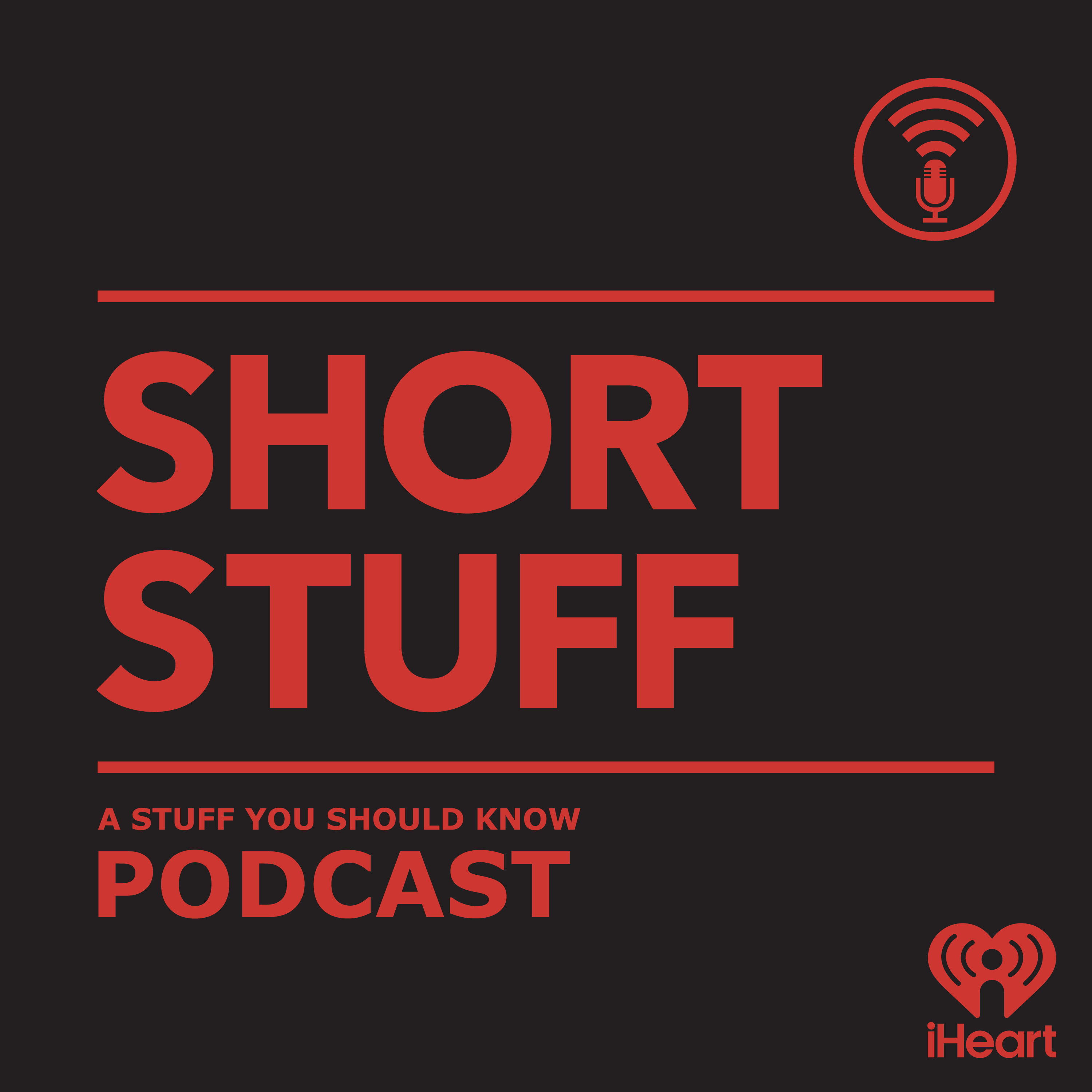Short Stuff: Devil Horns
Metal fans have many ways to express themselves, but none are as metal as throwing the devil horns. But who did it first?
See omnystudio.com/listener for privacy information.
Press play and read along
Transcript
Speaker 1 This is an iHeart podcast.
Speaker 2 Living with a rare autoimmune condition comes with challenges, but also incredible strength, especially for those living with conditions like myasthenia gravis or MG and chronic inflammatory demyelinating polyneuropathy, otherwise known as CIDP.
Speaker 2 Finding empowerment in the community is critical.
Speaker 2 Untold Stories, Life with a Severe Autoimmune Condition, a Ruby Studio production in partnership with Argenix, explores people discovering strength in the most unexpected places.
Speaker 2 Listen to Untold Stories on the iHeartRadio app, Apple Podcasts, or wherever you get your podcasts.
Speaker 3 Hail Satan, and welcome to the short stuff. I'm Josh, and there's Chuck, and this is our mid-metal two-parter short stuff
Speaker 3
that's more metal-adjacent than you can possibly imagine. We're talking about the origin of the Devil Horns hand sign that is as metal as metal gets as far as hand signs go.
Yeah.
Speaker 3
I've never had an opportunity to flash this, so I've never really done it. And I feel like a bit of a nerd, but I'm practicing because of that Judas Priest show.
Yeah.
Speaker 3 I figure that'll be a great time to whip it up for the first time. For sure.
Speaker 3 So where did this come from, Chuck?
Speaker 3 Well, I mean, let's talk a little bit about what it actually is because there's a bit of irony attached to this because when you're at a metal show doing this, you are,
Speaker 3 you know, what you're really doing is just a fun thing where you're like, this band rocks, and this is the
Speaker 3 appropriate sign that you do at a show like this to indicate that I think this rocks.
Speaker 3 But sort of the sub, the kind of funny subtext is like, yeah, Satan's horns.
Speaker 3 But what it really is in origin is sort of the opposite.
Speaker 3 It's known as a corna, which is Italian for horn.
Speaker 3 And it is what you do in old Italy, or even if you have a grandma in Italy who is
Speaker 3
still sort of superstitious, to ward off the evil eye. It's not like, yeah, Satan rocks.
It's like, no, get the out, Satan. Yeah, exactly.
So all of the metal fans are like, oh, that's the problem.
Speaker 3 That's why Satan never shows up.
Speaker 3 We've been doing this wrong. Yeah.
Speaker 3
So, yes. And like you said, it is.
totally associated with metal. And most people trace it back to Dio, Ronnie James Dio, who we surely have talked about by now in part one.
Speaker 3
At the very least, we definitely do in part two. He sang for Elf, Rainbow, Dio, obviously.
He also took over after Ozzy, R.I.P.
Speaker 3
was kicked out of Black Sabbath in 1979. Dio took over as the front man, which is a cool way of saying lead singer for Black Sabbath.
And Ozzy was known to like give
Speaker 3 like double peace signs
Speaker 3 as like his thing.
Speaker 3
And Dio was like, I can't do that same thing, but I got to come up with something. Everybody's going to be expecting some signature hand signal.
So
Speaker 3 he turned to the corona.
Speaker 3 That's right.
Speaker 3 What is the deal with those hand signals? It's like it's definitely a hard rock to metal thing.
Speaker 3
Because Van Halen did it with the with Sammy Hagar, they did that thing. And I don't know.
I just never feel like I see other bands doing that. It's interesting.
What did Sammy Hagar and Van Halen do?
Speaker 3 They did the
Speaker 3 double I love you, put together
Speaker 3
in such a way that, you know, it may have indicated something sort of naughty. I'll just say that.
Oh, gotcha. I remember White Lion made the W with their two index fingers and thumbs coming together.
Speaker 3 Did they really? No. No.
Speaker 3 And then Poison had the thing where you snap your fingers and then slap your hand on top of your closed fist three times.
Speaker 3 And then Klaus Meinbo would go, whoop, whoop, whoop.
Speaker 3 Exactly.
Speaker 3 All right. I don't believe that that one, so I didn't fall for that one.
Speaker 3 But, you know, a lot of people, if you're just a casual researcher, you'll just see everywhere that it was Ronnie James Dio.
Speaker 3
People have asked him this. There was an interview in 2001 where he said, I doubt very much that I would be the first one who ever did that.
That's like saying I invented the wheel.
Speaker 3
But I think you'd have to say that it made it fashionable. So he'd never claim to be the originator of that hand symbol, which is great.
Stand-up guy, Ronnie James Dio, R.I.P., of course.
Speaker 3 So, where did it come from? I mean, Gene Simmons in court said it was him, or tried to at least.
Speaker 3 So, here's the thing. Gene Simmons really outed himself as a dipstick.
Speaker 3 When, which time?
Speaker 3 Well, this time in particular, right? Because he tried to trademark his
Speaker 3 trademark hand sign, which is like the devil horns, but rather than the thumb closing over the two closed middle and ring fingers like you do with with the double sign. He stuck his thumb out.
Speaker 3
So there's three digits sticking out, right? That's I love you. It is.
It's the American Sign Language sign for I love you.
Speaker 3 Regardless of that, he tried to trademark it for himself, probably so he could sue people who continued to use it. And yeah,
Speaker 3 he tried to trademark an American Sign Language sign. That just kind of is pretty dipsticky, if you ask me.
Speaker 3 But what's interesting about it is all the press that this thing got started to actually tease out the people who probably really were responsible for introducing the metal horns to heavy metal or to music at least.
Speaker 3
Yeah. Should we take a break? Yeah.
All right. We'll be back with more of this mystery right after this.
Speaker 3 Attention, parents and grandparents. If you're looking for a gift that's more than just a toy, give them something that inspires confidence and adventure all year long.
Speaker 3 Give them a Guardian bike, the easiest, safest, and number one kids' bike on the market.
Speaker 2 Yeah, with USA-made kids-specific frames and patented safety technology, kids are learning to ride in just one day with no training wheels needed.
Speaker 2 It's why Guardian is America's favorite kids' bike and the New York Times and Wirecutters' top pick three years in a row.
Speaker 3 That's right. My daughter has a Guardian bike and she loves it, and that thing was really easy to put together.
Speaker 3 And get this: this holiday season, Guardian is offering their biggest deal of the year: over 40% in savings on all bikes, plus $100 in free accessories.
Speaker 3 Guardian bikes have become one of the most sought-after gifts of the season, and inventory is going fast, so don't wait. Join over a half a million families who've discovered the magic of Guardian.
Speaker 3 Visit guardianbikes.com to shop now.
Speaker 2
This podcast is sponsored by PayPal. Okay, let's talk holiday shopping.
From now through December 8th, you can get 20% cash back when you pay in for with PayPal. No fees, no interest.
Speaker 2 And this limited time offer is perfect for the Black Friday and Cyber Monday deals you've been eyeing. Save the offer in the app now.
Speaker 2 So whether you're shopping for your foodie friend or outdoorsy uncle, PayPal helps you make the most of your money this holiday.
Speaker 3
Expires December 8th. See PayPal.com/slash promoterms.
Subject to approval. Learn more at paypal.com/slash payin4.
PayPal Inc. NMLS 910-457.
Speaker 3 So before we get to who possibly may have created this, we should mention Geezer Butler, the bass player for Black Sabbath.
Speaker 3 He said, hey, look at our photo from 1969.
Speaker 3 I'm flashing this sign. So I did it before Dio, and I actually suggested that he do it.
Speaker 3 And also, this was on the cover of Yellow Submarine. Like John Lennon in animated form is making this sign on the cover of Yellow Submarine.
Speaker 3
That doesn't really clear it up because Geezer Butler is also wrong. So I'm going to let you.
lay it on us, my friend, of
Speaker 3 who maybe
Speaker 3 started this whole thing
Speaker 3 okay i'm thank you for giving me this one because this is amazing uh it turns out that it was probably a blonde 18 year old american girl named jinx dawson who uh was the lead singer of a band called coven which would be i guess psychedelic rock maybe but super dark psychedelic rock yeah did you listen to much of it i did it's not that great but it didn't even sound psychedelic to me and if you hadn't known the lyrics or the song titles it didn't seem even spooky.
Speaker 3 Yeah, you'd be like, is this like a Paul Revere in the Raiders cover band or something?
Speaker 3 Sort of. It was interesting.
Speaker 3 Yeah, there was an article by a guy named Dom Lawson in Metal Hammer.
Speaker 3
And he called it, he said it was scarcely any kind of metal, but it flowed with a similar dark magnetism. I think he kind of nailed it on the head.
Yeah, well, what's interesting is...
Speaker 3 Like, it is ultra-metal with imagery and lyrics and song titles, but it's such a weird thing for your brain to hear that kind of thing coming out of something that's not metal-sounding, you know?
Speaker 3 Right, exactly.
Speaker 3 This is a 1969 album called Witchcraft Destroys Minds and Reaps Souls. And it had songs like For Unlawful Carnal Knowledge on it, packed with Lucifer.
Speaker 3 And then, very spookily, the first track on this album was called Black Sabbath.
Speaker 3 Yeah, can I read a few other song titles?
Speaker 3 White Witch of Rose Hall.
Speaker 3 Choke, Thirst, Die.
Speaker 3
That's just one song. Yeah, yeah.
Commas in between.
Speaker 3
Each shoots and leaves. Wicked Woman is one.
And there was one called Dignitaries of Hell.
Speaker 3 She, and so Jinx Dawson, the reason why she's like probably the one who did this, she was actually raised in a left-hand path house and was raised as a Satanist in the Anton LeVay Alistair Crowley sense, the occult sense.
Speaker 3 And another reason why it's attributed to her and her band Coven is because no one,
Speaker 3
no one was doing this, especially in the States. They were from Chicago.
They essentially had no
Speaker 3 inspirations aside from the real-life left-hand path initiations that Jinx Dawson had been raised around.
Speaker 3 Yeah, I mean, if you look at the, I think it's on the back cover, right, of their album, once again, witchcraft destroys minds and reaps souls. I just want to read that like five more times.
Speaker 3
They're doing that sign. I mean, it's very clear.
It's not an accident. It's very much on purpose.
It's exactly what it is.
Speaker 3 And it was so convincing that in 2017, when Gene Simmons was trying to trademark this stuff, they came forward and Gene Simmons was like, you know,
Speaker 3 didn't know about these guys. No.
Speaker 3 Someone else who said they didn't know about these guys was Ozzie Osborne and Geezer Butler and Black Sabbath. Yeah.
Speaker 3
And supposedly, and it gets even spookier, the bassist for Coven's name was Greg Oz Osborne. Yeah.
This is happening simultaneously in Chicago.
Speaker 3
Yes, as Black Sabbath is changing their name from Earth to Black Sabbath. Yeah.
And Black Sabbath has always maintained this is just some spooky coincidence. Sure.
Speaker 3 It's believable.
Speaker 3 There's an article by a guy named Dom Lawson, that same Dom Lawson from Metal Hammer magazine, who basically says like their album got zero play. It just didn't make it over to the UK.
Speaker 3 There's almost no way they would have heard this.
Speaker 3 And the reason why is because their album was released right around the time of the Sharon Tate murders, the Manson murders, and America was not in the mood for stuff like satanic rituals.
Speaker 3 Or bad music. Yeah.
Speaker 3 Sure.
Speaker 3
But Lester Bangs heard it. He compared Black Sabbath to a combination of cream and coven.
So at least in the mind of legendary rock critic Lester Bangs, Coven was a
Speaker 3 at least somehow related thematically to Black Sabbath. Yeah, I think it was like take the music of Cream and combine it with the spooky imagery and lyrics of Coven, or Coven, as I like to say.
Speaker 3 Oh, yeah, you could say it that way too. I forgot.
Speaker 3 Yeah, that
Speaker 3 seems to be the deal. Yeah, so I guess it's unclear exactly how much direct influence they had, but at the very least, everybody tips their hat to them for being pioneers in that respect.
Speaker 3 Yeah, well, at the very least, it shut Gene Simmons off.
Speaker 3
Right, exactly. So hats off to Jinx Awesome for that.
And then we can't talk about the devil horns without at least a nod to the kitsuni side. Kitsuni means fox.
Speaker 3 And in Japan, if you go to a metal concert, say like a baby metal concert, that will come up at the end of part two,
Speaker 3 you will see something similar to a devil sign, but rather than the ring finger and middle finger bent down and the thumb crossing them, the ring finger and middle finger come together and are pressed against the thumb with the pinky and the index finger up.
Speaker 3
And what you're doing is you're making a face of a fox. And it's very Japanese.
That's what they do at Japanese metal shows.
Speaker 3
You know, I didn't understand any of that until I just sort of did it as you were following along. And I was like, oh, yeah, look at that little fox.
Great. It makes a nose, is what it does.
It does.
Speaker 3 A little fox face. And you can be like, oh, one more fox.
Speaker 3 If we have one extra minute here, I would like to do a real-time update, breaking news.
Speaker 3 In part one, I rattled off my top five metal bands, and I forgot because I was listening to Hair Nation again later that day.
Speaker 3 And I have an update and I hate to do it, but I'm going to, I guess, bump the scorpions out
Speaker 3 in favor of Tesla.
Speaker 3
Okay. All right.
I can see that. They're similar in level.
Yeah.
Speaker 3
I feel bad. I forgot about Tesla.
And while I don't dive deep into Tesla, I think I'm going to go on record and say that like
Speaker 3
three of their songs are some of the best songs of that era out of any band. So I have to put them in there.
Okay.
Speaker 3 Well, while we're talking, while we're doing updates, I watched
Speaker 3
Yumi showed me some, I guess, Instagram clips of Ozzie's funeral and Sharon Osborne just losing. Brutal.
It's so hard to watch. But then also she showed me a clip of him singing
Speaker 3
Coming Home, Mom. I'm Coming Home.
Yeah, great song. I think he's sitting on like a throne in this stadium in Birmingham that last show, like right before he died.
Oh, Oh, yeah. It's it's amazing.
Speaker 3
I hadn't seen it when we recorded part one of the heavy metal, but it's yeah, it's quite stirring. It's really neat to see.
So I'm like, man, that is a really great way to go out, you know?
Speaker 3 Yeah, I mean, he practically passed away on stage, you know. Right.
Speaker 3
So we've said it before, said it again. R.I.P., Ozzy Osborne, one of the metal greats.
And I guess Chuck Short's stuff's out, right? That's right.
Speaker 1 Stuff You Should Know is is a production of iHeartRadio. For more podcasts from iHeartRadio, visit the iHeartRadio app, Apple Podcasts, or wherever you listen to your favorite shows.



